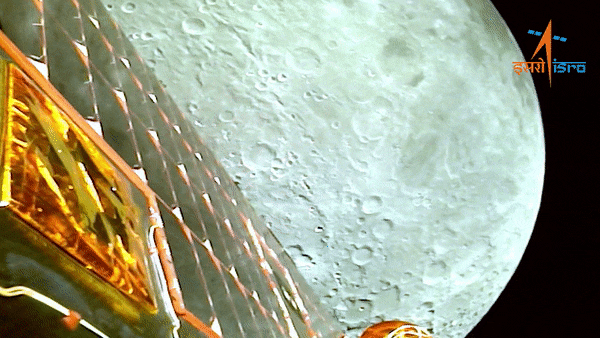ISRO’s Chandrayaan-3 hints at ice deposits on the moon and water reserves
Summary:
New Research from Chandrayaan-3 Reveals Widespread Ice Presence on the Moon
A recent study based on data from India's Chandrayaan-3 mission suggests that ice may be present at more locations near the Moon's poles than previously thought. The research, published in Communications Earth and Environment, highlights the influence of local temperature variations on ice formation.
Key Findings:
Temperature fluctuations: Surface temperatures at the landing site varied dramatically, with daytime peaks reaching 82°C and nighttime lows of -170°C.
Ice formation: Slopes facing away from the Sun, at an angle of 14 degrees or greater, may be cold enough to allow ice to accumulate near the surface.
Implications for future lunar missions: The study's findings suggest that ice could be a vital resource for future human exploration and habitation on the Moon.
Future Research Directions:
Further measurements: Additional measurements and innovative techniques are needed to extract and utilize ice for long-term lunar sustainability.
Water-ice scouting: High-latitude regions are promising locations for water-ice scouting and resource prospecting.
Chandrayaan 3: Launch and Discussions
Re: Chandrayaan 3: Launch and Discussions
Chandrayaan-3 Completes Two Years Today: India Marks Historic Lunar Mission and First Soft Landing Near Moon’s South Pole
Chandrayaan-3, a historic achievement of India’s science and determination, has completed two years today. The primary objective of this mission was to place a lander and rover in the highlands near the Moon’s south pole and to demonstrate end-to-end landing and roving capabilities. On this day in 2023, LVM3 M4 rocket developed by Indian Space Research Organization (ISRO) successfully launched Chandrayaan-3 into orbit.
Re: Chandrayaan 3: Launch and Discussions
Chandrayaan-3 returns to the Moon for rare flyby, sends critical data
This unique gravitational tour has provided the Indian Space Research Organisation (Isro) with a treasure trove of operational data, offering new insights into spacecraft navigation and orbital mechanics.
Chandrayaan-3 flying behind the Moon ahead of historic landing in 2023. (Photo: Isro)
New Delhi,UPDATED: Nov 13, 2025 21:29 IST
Chandrayaan-3’s Propulsion Module (CH3-PM) has achieved a rare and scientifically significant milestone by re-entering the Moon’s sphere of influence (SOI) for a series of lunar flybys, more than two years after the historic soft landing of the mission’s lander and rover in August 2023.
This unique gravitational tour has provided the Indian Space Research Organisation (Isro) with a treasure trove of operational data, offering new insights into spacecraft navigation and orbital mechanics.
Launched on July 14, 2023, aboard an LVM3 rocket from Sriharikota, the Chandrayaan-3 mission was primarily designed to demonstrate a safe lunar landing, enable rover operations, and conduct crucial in-situ scientific experiments.
The spacecraft was split into three modules: the Lander, the Propulsion Module, and the Rover. After achieving its primary objectives on August 23, 2023, the lander and rover silently made history on the Moon’s rugged surface, while the propulsion module remained in lunar orbit at an altitude near 150 km, supporting continued communications and scientific payloads.
In October 2023, Isro executed trans-Earth injection (TEI) manoeuvres, repositioning the Propulsion Module into a high-altitude Earth-bound orbit. For over two years, the craft’s path was delicately influenced by the gravitational fields of both Earth and the Moon.
This intricate orbital dance culminated when the module once again entered the Moon’s SOI on November 4, 2025, an event marking the transition where lunar gravity dominates its motion.
The first recorded lunar flyby occurred on November 6, 2025, at a distance of 3,740 km from the lunar surface, though it was outside the Indian Deep Space Network’s (IDSN) visibility range. A second, closely monitored flyby took place on November 11, 2025, bringing the module within 4,537 km of the Moon and well within observation capabilities.
These events noticeably altered the satellite's orbital parameters, expanding its orbit size from 100,000 x 300,000 km to a massive 409,000 x 727,000 km and shifting its inclination from 34° to 22°.
Throughout these manoeuvres, Isro’s ISTRAC network kept a vigilant watch over CH3-PM, ensuring it maintained safe separation from other lunar orbiters and catalogued valuable data on gravitational interaction and satellite dynamics. Mission controllers report the spacecraft remains in nominal condition, with no threats or collisions detected.
These rare lunar flybys have energised planetary scientists and mission planners, showcasing Isro’s growing expertise in post-landing spacecraft utilisation and expanding humanity’s playbook for future deep space missions.
